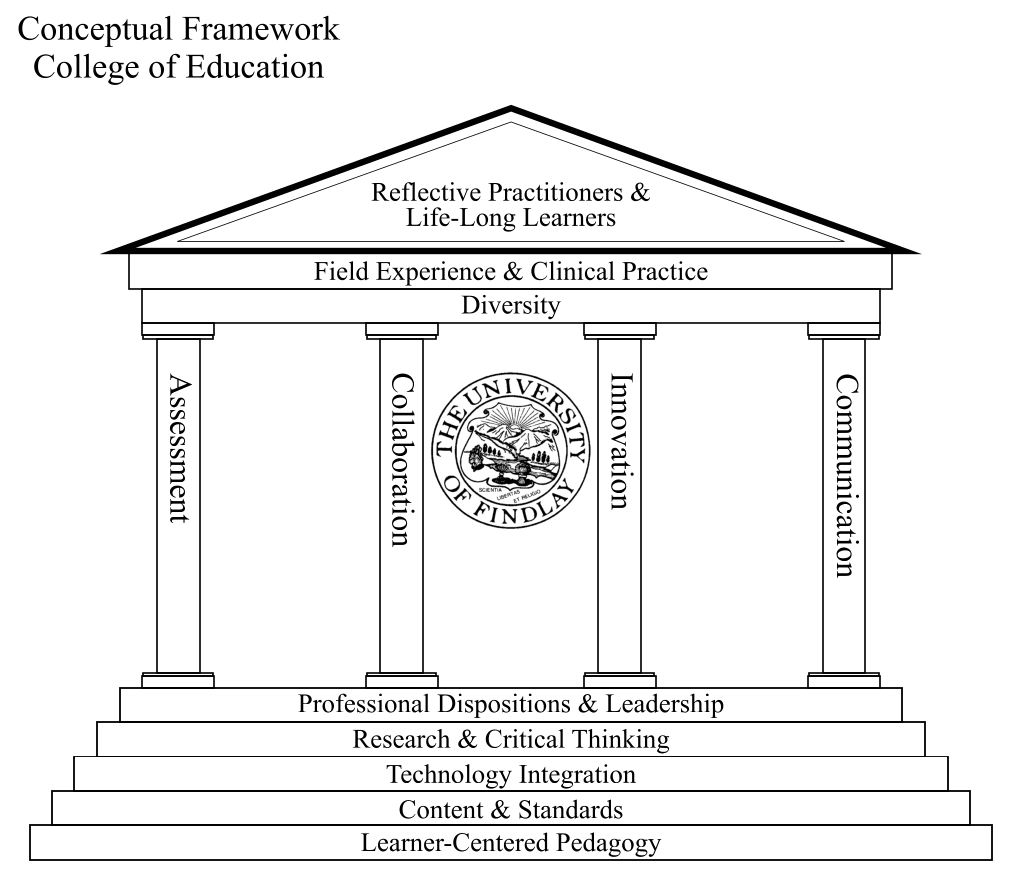COE Mission
The College of Education prepares caring, inclusive, innovative, and highly qualified professionals.
COE Vision
The faculty of the College of Education will meet the challenges of continuous change in the preparation of reflective practitioners and lifelong learners. All program completers will have the knowledge, skills, and dispositions to positively impact the learning of students in p-12 classrooms.
Program Quality
Standards-based programs, reinforced through clinical practice, develop the knowledge, skills and dispositions of successful teachers and reflect a commitment to excellence, scientifically-based research, learner-centered pedagogy, technology integration, innovation, collaboration, outcomes assessment, service learning, and professionalism. The College of Education is committed to continuous improvement through a data-driven, rigorous assessment system so that candidates leaving our programs will be able to synthesize their knowledge, skills, and dispositions to meet standards in innovative ways. The unit’s mission is to encourage candidates to be sensitive and responsive to individual and cultural differences. Thus, they are engaged as change agents in collaboration with their schools and communities and positively impact p-12 student learning.
Philosophy Statement
The COE faculty at the University of Findlay believes in a constructivist philosophy that lifelong learners and reflective practitioners are developed in institutions wherein: engagement in inquiry, reflection, research, and assessment support the development of caring, competent, and highly qualified candidates; professional programs are consistent with state and national standards; there is synthesis among curriculum, instruction, and clinical practice; commitment to active professional collaboration among regional p-12 communities is implemented at every program level; individual differences and diversity are valued in the development of all effective instruction; emphasis is placed on professional responsibility and accountability as a means of developing lifelong learners and reflective practitioners; technology is an integral part of all programs.

The University of Findlay College of Education Goals and Objectives
The goals and objectives of the College of Education include the Pathwise Domains and Criteria and correlate to the Ohio Performance Standards, which are based upon the Interstate New Teacher Assessment and Support Consortium (INTASC) standards. There are some additional outcomes, unique to the College of Education as well. Upon completion of the licensure programs at the University of Findlay, candidates will:
UF A. Organize content knowledge for student learning
A1. Be familiar with relevant aspects of students’ background knowledge and experiences.
A2. Articulate clear learning goals for lessons that are appropriate to the students.
A3. Demonstrate an understanding of the connections between content that was learned previously, current content and content that remains to be learned in the future.
A4. Create or select teaching methods, learning activities and instructional materials or other resources that are appropriate to the students and that are aligned with the goals of the lesson.
A5. Create or select evaluation strategies that are appropriate for the students and that are aligned with the goals of the lesson.
UF B. Create an environment for student learning
B1. Create a climate that promotes fairness.
B2. Establish and maintain rapport with students.
B3. Communicate challenging learning expectations to each student.
B4. Establish and maintain consistent standards of classroom behavior.
B5. Make the physical environment as safe and conducive to learning as possible.
UF C. Teach for student learning
C1. Make learning goals and instructional procedures clear to students.
C2. Make content comprehensible to students.
C3. Encourage students to extend their thinking.
C4. Monitor students’ understanding of content through a variety of means, provide feedback to students to assist learning and adjust learning activities as the situation demands.
C5. Use instructional time effectively.
UF D. Exhibit professionalism as a teacher
D1. Reflect on the extent to which the learning goals were met.
D2. Demonstrate a sense of efficiency.
D3. Build professional relationships with colleagues to share teaching insights and to coordinate learning activities for students.
D4. Communicate with parents or guardians about student learning.
Additional COE Objectives:
Candidates will utilize technology for professional management and teaching strategies.
Candidates will apply their knowledge of research in planning for the diverse needs of children.
Candidates will foster relationships with students, colleagues, parents, and the larger community to assure student learning.
Candidates will use appropriate standards in planning for students.
The College of Education has identified dispositions related to the outcomes. There is one for each of the four domains and one for the additional COE objectives. These dispositions are compatible with the Conceptual Framework, the Ohio Performance Standards and the INTASC standards as coded below.
Dispositions:
Organized: Works in systematic or efficient ways to meet the needs of all students. (INTASC 1, 2, 3, 4, 5, 6, 7, 8; Domain A: Organizing Content Knowledge for Student Learning)
Learner-Centered: Focuses on student well-being and learning. (INTASC 1, 2, 3, 4, 5, 6, 7; Domain B: Creating an Environment for Student Learning)
Reflective: Reviews previous actions, events, or results to make decisions. (INTASC 9; Domain C: Teaching for Student Learning)
Lifelong Learner: Grows in professional and pedagogical knowledge. (Domain D: Teacher Professionalism)
Innovative: Takes new or original approaches to foster student learning. (INTASC 3, 5, 6, 8; Additional UF Objectives)
Ohio’s Performance Standards for Entry Year Assessment (based upon INTASC)
Subject Matter
Understanding and knowledge to create effective learning experiences
Student Learning
Creates learning opportunities based on how students learn and develop
Diversity of Learners
Provides instruction to accommodate diversity among learners
Planning Instruction
Plans instruction based on students, content, and curriculum models
Instructional Strategies
Uses variety of instructional strategies for critical thinking and problem-solving
Learning Environment
Provides positive, interactive, self-motivating, engaging learning activities
Communication
Uses verbal, non-verbal, technology, multi-media forms of communication
Assessment
Uses formal and informal assessments to evaluate student progress
Professional Development
Pursues professional development activities to improve future performance
Student Support
Works with students, parents, families, and communities to support student learning.